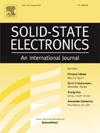Exploring TEG parameters for optimal body heat harvesting in wearable devices
IF 1.4
4区 物理与天体物理
Q3 ENGINEERING, ELECTRICAL & ELECTRONIC
引用次数: 0
Abstract
Thermoelectric generators harness human body heat to power wearable electronic devices and are crucial for developing self-sustaining wearable systems for health and environmental monitoring. This research focuses on optimizing the power output of body heat-driven wearable thermoelectric generators, while ensuring user comfort. It emphasizes minimizing heat loss, maintaining a significant temperature differential across the thermoelectric material, and designing compact generators. Investigations explored temperature-regulated hot surfaces at various body sites including the wrist, upper arm, and chest. Power levels were recorded during activities such as running and walking. Findings indicate that power generation was most effective at the upper arm, peaking at 71.2 millivolts with a thermoelectric generator equipped with a heat sink silver spreader and silicon insulator during summer conditions. The study also evaluated the feasibility of using upper arm thermoelectric generators to power wearable electrocardiogram sensors. In comparison, while thermoelectric generators at the wrist benefited from airflow in winter, achieving up to 29.3 millivolts, those at the chest showed superior power output. This research underscores the potential of strategically placed thermoelectric generators in enhancing the functionality of wearable technologies.
探索可穿戴设备中最佳体热采集的TEG参数
热电发电机利用人体热量为可穿戴电子设备供电,对于开发用于健康和环境监测的自我维持的可穿戴系统至关重要。本研究的重点是优化人体热驱动的可穿戴热电发电机的功率输出,同时保证用户的舒适性。它强调最大限度地减少热损失,在热电材料中保持显著的温差,并设计紧凑的发电机。研究探索了不同身体部位的温度调节热表面,包括手腕、上臂和胸部。在跑步和散步等活动中记录能量水平。研究结果表明,上臂的发电效率最高,在夏季条件下,配有散热片、银片和硅绝缘体的热电发电机的峰值电压为71.2毫伏。该研究还评估了使用上臂热电发电机为可穿戴式心电图传感器供电的可行性。相比之下,手腕上的热电发电机在冬季受益于气流,可达到29.3毫伏,而胸部的热电发电机则表现出更好的功率输出。这项研究强调了战略性放置热电发电机在增强可穿戴技术功能方面的潜力。
本文章由计算机程序翻译,如有差异,请以英文原文为准。
求助全文
约1分钟内获得全文
求助全文
来源期刊

Solid-state Electronics
物理-工程:电子与电气
CiteScore
3.00
自引率
5.90%
发文量
212
审稿时长
3 months
期刊介绍:
It is the aim of this journal to bring together in one publication outstanding papers reporting new and original work in the following areas: (1) applications of solid-state physics and technology to electronics and optoelectronics, including theory and device design; (2) optical, electrical, morphological characterization techniques and parameter extraction of devices; (3) fabrication of semiconductor devices, and also device-related materials growth, measurement and evaluation; (4) the physics and modeling of submicron and nanoscale microelectronic and optoelectronic devices, including processing, measurement, and performance evaluation; (5) applications of numerical methods to the modeling and simulation of solid-state devices and processes; and (6) nanoscale electronic and optoelectronic devices, photovoltaics, sensors, and MEMS based on semiconductor and alternative electronic materials; (7) synthesis and electrooptical properties of materials for novel devices.
 求助内容:
求助内容: 应助结果提醒方式:
应助结果提醒方式:


